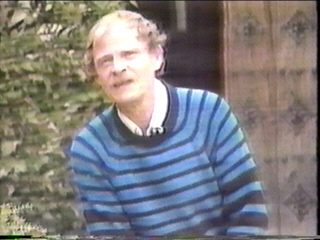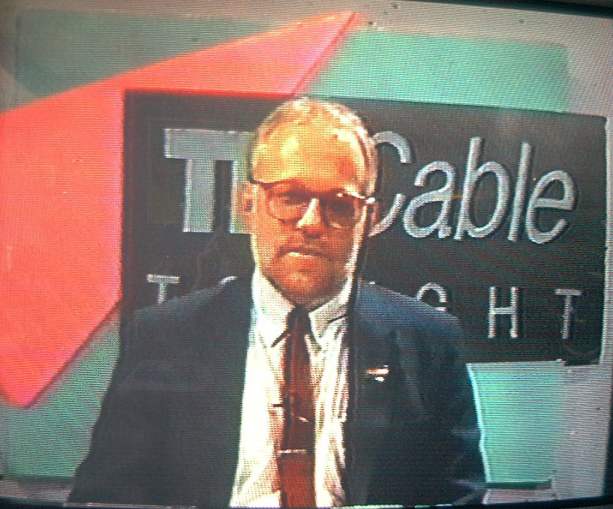Return to Cream City Foundation main page. |

|
||||||||
|
The Milwaukee Gay/Lesbian Cable Network consisted of a small group of extremely dedicated individuals who wanted to use the newly available cable network franchise's public access facilities to produce a regular program on gay and lesbian issues. The two Executive Producers, Mark Behar and Bryce Clark, approached the Cream City Foundation Board in late 1987 seeking funding of that programming: mostly the cost to duplicate tapes, and other miscellaneous expenses. As a result, and in order to provide on-going funding, the CCF invited the Cable Network to operate as a subcommittee of the CCF. The 30-minute programs were produced monthly (with a few exceptions), each show broadcast about 3 times a month on Warner Cable channel 14. The magazine style format covered an average of 6 to 7 segments in the half-hour time drame, and featured tight directing and split second transitions from one segment to another. The programs were a combination of in-studio news presentaions, interviews, and discussions, plus segmnents tapes out in the community at various events or venues. There were also occasional call-in segments. Initial hosts were Juana Sabatino and Rick Poplawski, with Rick later being replaced by Michael Lisowski. A favorite segment of many shows was "GayStory", narrated by Dr. Terry Boughner. These segments featured historical overviews of gay and lesbian life and people. Early on, Milwaukee Gay/Lesbian Cable Network won the Cream City Business Association's "Outstanding Community Achievement" award, and several national gay/lesbian press associations asked that tapes be submitted for judging in national contests. The first anniversary of the program's showing on MATA (Milwaukee Access Telecommunications Authority), brought two surprises. First, the Tri-Cable Tonight programming won the top two awards of the year at a MATA award program: the CCF sponsored group won first place for "Overall Best Regular Series", as well as the award for the "Best Achievements in Minority Programming". The second surprise was the high number of "straight" people calling in to the program's first anniversary special. Most of these people were seeking information to help them understand and deal with cherished friends and relatives who were gay/lesbian. (See several articles on the 1st Anniversary in the Jan-Feb 1989 CCF Update newsletter.) Over the course of the program, it won several local and national awards. It was the first Milwaukee Public Access TV program to ever win First Place in the national Hometown Video Awards program (in 1989); it was only the 2nd GLBT program to win that award. It also won several First Place local "Philo" awards, sponsored by Milwaukee Access Telecommunications Authority. Overall, this national and local recognition highlighted the pioneering and leadership spirit that may have set the tone for all nationwide GLBT TV/cable programming back in those early days of gay involvement in television production. The Milwaukee Gay/Lesbian Cable Network also created and broadcast several special hour-long programs. In 1990, after almost a year without regular programming, the Milwaukee Gay/Lesbian Cable Network began work on two new programs. One, named The New Tri-Cable (NTC), focused on new, less complicated programming, mainly featuring issues-orientated programs featuring a panel of persons, sometimes with opposing viewpoints. With no field shoots, and no pre-production edits, the aim was to tape two programs at a time, cablecasting a new program every two weeks. These programs ran 90 minutes each. In addition, a gay comedy program, "Yellow on Tuesday", was begun in summer 1990. This comedy program featured shorts, skits and parodies. Co-creator Mark Behar wrote the following summary of Tri-Cable in 2022: Back in 1986-87, a bunch of gay, lesbian, bi, trans, friends & allies responded to a gay newspaper ad to gauge interest in creating a Milwaukee Gay & Lesbian video & public access television group. Cream City Foundation provided us with some seed money. Milwaukee Access Telecommunications Authority (MATA) and Milwaukee's Warner Cable TV (later Time Warner, now Spectrum) provided free training of community members to use analog video, editing, and studio equipment to produce Milwaukee community programming for their two public access television stations. Over the next several years, co-founders and executive producers Mark P. Behar and Bryce Clark pulled together a diverse team (see list below) that created 5 solid years of cable TV programming. Afterwards, Michael Lisowski continued a live hour long show, Queer Television (Q-TV) with featured guests and call-ins that continued through 2018. Over 100 different guests were featured from November, 1987 through April, 1992 including most of Milwaukee's LGBT leaders, movers & shakers as well as visiting authors, entertainers, dignitaries and politicians. LGBT history was celebrated monthly through a "Gaystory" segment by gay history professor Terry Boughner. Regular editorials and opinions were given by gay political activist Ralph Navarro. Legal issues were featured by gay attorney Stephen Byers. Lesbian activist and writers Jamakaya contributed. There were numerous feature stories about GAMMA's softball, bowling, and volleyball activities, the Holiday Invitational Tournament, Black and White Men Together, Brady East STD (BESTD) Clinic, Milwaukee AIDS Project, Lesbian Alliance of Metro Milwaukee, PrideFest, HagRag, InStep, and others. The Milwaukee Lesbian Gay Cable Network produced the first LGBT program called Tri-Cable Tonight (TCT) that went live in 1987; after two years, the New Tri-Cable Tonight (NTCT) followed as mostly all in-studio production without remote shoots. A specialized comedy program, Yellow on Thursday (YoT) expanded from "News Updates by W.W. Wells, III" during the TCT program to full comic program, YoT. (W.W. Wells, III was the pseudonym for William "Bill" Attewell, who published one of Milwaukee's LGBT Newspapers at the time.) The monthly show required our team to meet regularly to brainstorm ideas and how to implement them with remote location video shoots, script and teleprompter writing, editing, and eventually culminating in a studio production that pulled everything together into a 30-90 minute monthly program. Each remote video camera and 3/4" tape recorder and batteries along with audio and specialized lighting equipment required several heavy suitcases! After video footage was collected, it was edited using specialized 3/4" video tape decks to transfer sources to a final video master tape. Studio shoots required learning the use of different audio and lighting and large rolling cameras with an analog teleprompter that required content to be typed into the system prior to the actual event! No laptop computers, smartphones, Bluetooth devices, LED lights, flash drives or digital video technologies!! How'd we come up with the program names? TCT stood for the pink triangle symbol commonly used for LGBT people at the time. We abbreviated it from "Triangle" to "Tri" because we were "trying" to produce something that had never been done before. And that each of the corners of the triangle focus on the 3 main components of our movement: Lesbians, Gay men, and Transgendered people. "Yellow on Thursday" was a practice of closeted LGBT people wearing yellow clothing on Thurdays in Milwaukee in the 1950s & 1960s as a way of disclosure to other mostly closeted LGBT people here in Milwaukee. (In some cities it was green!) Both program names lent themselves to interesting graphics for set design. Any additions or corrections to this? Please share! I remember what a significant accomplishment our production represented! We gathered an incredibly diverse group of fifty Milwaukee LGBT artists, entrepreneurs, geeks, nerds, professionals, and activists during the early days of the HIV epidemic! Similar efforts occurred in other cities (not New York or LA/Hollywood, by the way), but ours was the first LGBT production company in the US to win first place in the Hometown USA Video Festival in 1989! We have a lot to be proud about. This is our history! Use THIS LINK to view the videos of the Tri-Cable shows. The UWM Archives LGBT Collection holds a considerable amount of the Milwaukee Gay/Lesbian Cable Network's historical papers. UWM Archives has the following collection description: The Milwaukee Gay/Lesbian Cable Network (MGLCN) was a volunteer group that produced regular and special programming on gay and lesbian issues for Milwaukee's public access cable channel. MGLCN was aided by the Milwaukee Access Telecommunications Authority (MATA), a non-profit corporation created to provide citizens with access to Milwaukee's cable system. Specifically, MATA provided MGLCN with the equipment, facilities, training, channel space, and support necessary to produce and cablecast its local television programs. MGLCN executive producers included Mark Behar and Bryce Clark. From late 1986 to mid-1987, MGLCN produced a number of special programs. The first of these consisted of scenes from the Clavis Theatre's production of Larry Kramer's The Normal Heart, which was cablecast December 22, 1986. Other special programs included the 1987 annual awards program of the Cream City Business Association, Minnesota legislator Karen Clark on Wisconsin's gay rights law, and U.S. Surgeon General C. Everett Koop on AIDS, among others. In May 1987, MGLCN approached the Cream City Foundation (CCF) with a request for $400 to finance the premier episode of its first regular program, Tri-Cable Tonight. The show was described as "cable television series exploring the color and diversity of Milwaukee's Gay and Lesbian Community." CCF responded with a grant of $3,000 to fund the first six episodes and committed to raising additional funds to assure continued development of the program. MGLCN agreed to operate as a subcommittee of CCF's Development and Public Relations Committee (it became a full committee in March 1988). The first episode of Tri-Cable Tonight aired October 27, 1987, and Milwaukee joined the ranks of only ten other cities in the United States with regular gay/lesbian programming. The program concluded in December 1989. During its two-year run, Tri-Cable Tonight earned many awards, including first place in the 1989 Hometown USA Video competition, several MATA awards, and the Cream City Business Association's President's Award. In 1990, MGLCN launched two series. Yellow on Thursday was a comedy program that aired on an irregular basis from June 1990 to October 1991 and consisted of five, thirty-minute episodes. The New Tri-Cable consisted of moderated panel discussions on a specific issue. The program lasted from November 1990 through March/April of 1992 and consisted of twenty-eight episodes. Collection consists of regular and special programming produced by the Milwaukee Gay/Lesbian Cable Network (MGLCN) from 1987 to 1994. MGLCN was established by a group of individuals who wanted to produce regular programming on local gay and lesbian issues using the newly available facilities of MATA Community Media. MGLCN produced Tri-Cable Tonight, a monthly news and entertainment program; the New Tri-Cable, a panel discussion program; and Yellow on Thursday, a comedy show featuring shorts, skits, and parodies. Following is a list of the volunteer production crew and our regular on-air guests (alphabetically by first name), as compiled by Mark Behar in 2022: Mark Behar (Co-Executive Producer, featured guest, crew, co-founder) |
 Tri-Cable Tonight set  GayStory logo  GayStory host Dr. Terry Boughner  New Tri-Cable logo  Moderator Michael Lisowski |
|
|
|
Credits: web site concept, design and arrangement by Don Schwamb,
Various materials contributed by CCF and Mark Behar.
Last updated: March-2022.

This work is licensed under a
Creative Commons Attribution-NonCommercial-ShareAlike 4.0 International License.